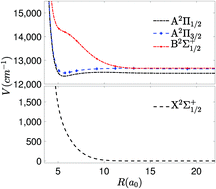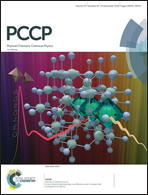Excited interatomic potential energy surfaces of Rb + He that correlate with Rb terms 52S through 72S†
Abstract
The excited state interatomic potential energy surfaces for Rb + He are computed at the spin–orbit multi-reference configuration interaction level of theory using all-electron basis sets of triple and quadruple-zeta quality that have been contracted for Douglas–Kroll–Hess (DKH) Hamiltonian and includes core-valence correlation. Davidson-Silver corrections (MRCI+Q) are employed to ameliorate size consistency error. An extrapolation of CASSCF energies is performed using the procedure of Karton and Martin whereas extrapolation of correlation energy is performed using an expression involving the inverse powers of (lmax + 1/2), the highest angular momentum value present in the basis set. The spin–orbit energies in the limit of complete basis set are obtained by replacing the energy eigenvalues in the spin–orbit matrix by the relativistic-corrected MRCI+Q energies extrapolated to the complete basis set limit. MRCI diabatic potential energy surfaces for a few selected 2Σ states are calculated to study the general topology and avoided crossings and repulsive form of the 6s 2Σ+ state. Important features of the potential energy surfaces are discussed with implications for alkali laser spectroscopy.



 Please wait while we load your content...
Please wait while we load your content...
